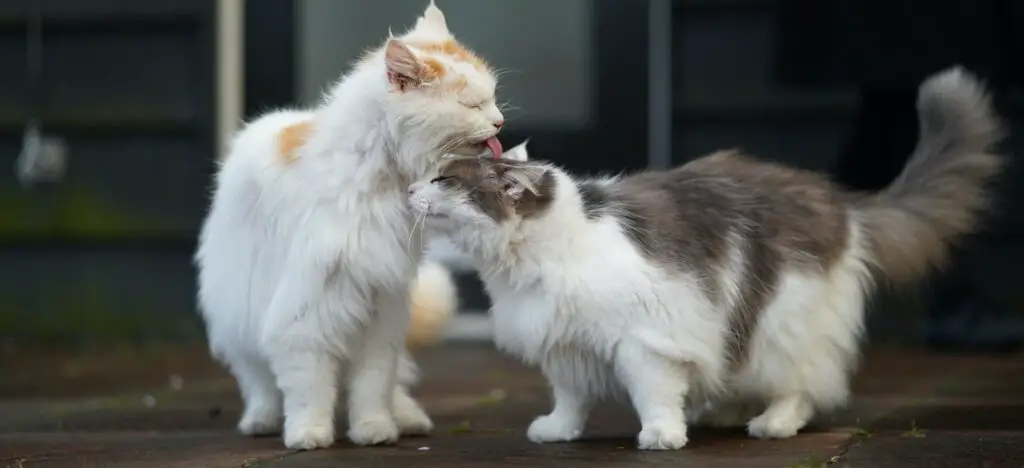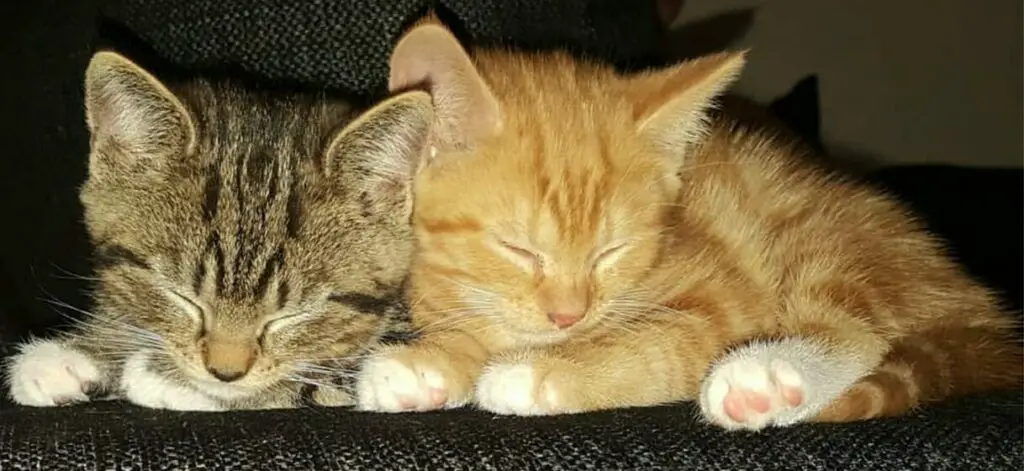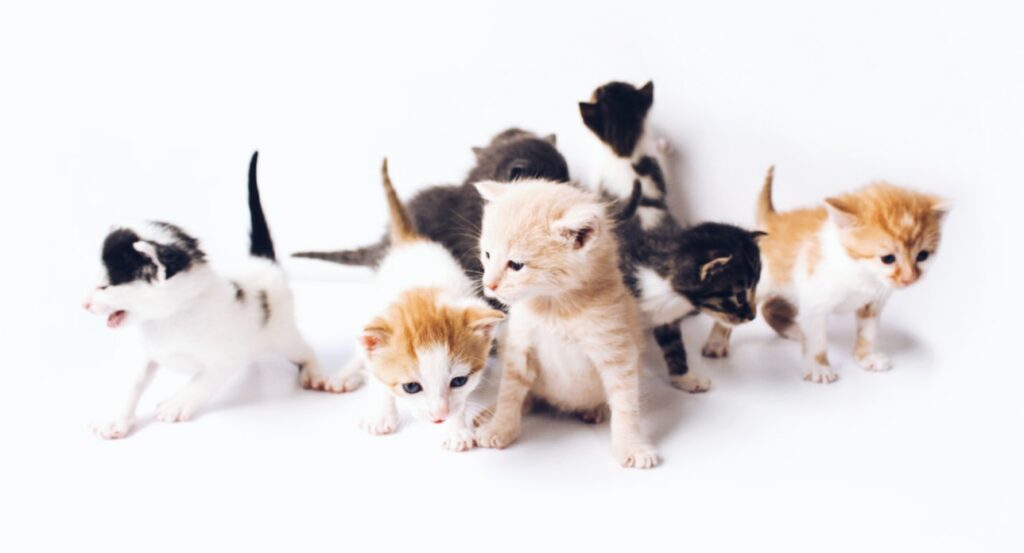
Key points
- Generally, cats that are similar in age, sex, temperament, and breed, will be the easiest to introduce;
- It might take two cats anywhere from a few weeks to a few months to become friends;
- If one of the cats seems to be extremely aggressive after the first meeting, you should consider separating both pets again for some time.
Many cat owners consider bringing home a second feline. If you are also thinking about getting a new cat in addition to your current pet, you should get ready for a challenging introduction. You may have heard that cats are solitary hunters. The average prey caught by a small cat is more of a snack than a full meal. A mouse or a young bird cannot be divided among several pack members; no group of cats would be satisfied with such prey. For this reason, the cat hunts and eats its prey single-handedly. Hunting makes up a large part of a cat’s life, so wild cats live alone for most of the year.
Of course, contact with humans has changed the cats’ character. Indoor cats are used to our company. However, if you want to create a friendship between two cats, you should proceed cautiously and refrain from spontaneous purchases. Making a plan and putting some framework conditions in place before getting a new cat can help make the introduction a success!
First of all, you should make sure that sufficient resources are available to ensure that there are no fights between your pets. In practical terms, this means that there should be no competition for food or quiet resting places. A large, airy, and above all, clean litter box should also be available for each cat. The same is true of the attention provided by you and your family members. If these basic requirements are met, there’s no reason not to purchase a second cat.
Table of Contents
Introducing Cats: The First Contact
When it comes to the actual first contact, both animals will be much more nervous than you, as the resident cat will be confronted with an intruder on its territory. Avoid surprising or harassing any of the cats. Give both animals space. Neither of the animals should be locked or restrained in a basket. Instead, you should offer them retreat options.
However, as a rule, contact with an unknown animal shouldn’t be a problem for well-socialized and mentally healthy cats. Depending on the experience and character of the individual cats, they may smell or ignore each other during the first meeting.

If the second cat has already spent a few days in a separate room, your resident cat will probably have an inkling of what is going on. Open the door to the room and keep any escape routes open for both animals. Follow the same procedures even if you release the second cat straight from the transport basket into your cat’s territory.
Leave it up to your cats to decide what to do next by withdrawing and watching the two from a distance. This way, you will give your old cat the opportunity to sniff the newcomer in peace without feeling pressured. Give the cats some time and only intervene in an emergency.
For some felines, it is common to exhibit some form of aggression while meeting a new cat. To avoid creating hostile situations, you should be aware of the warning signs when introducing cats.
Warning Signs When Introducing Cats
Cats are hissing at each other
Cats usually use hissing to express fear and intolerance. A resident cat is more likely to hiss at the new cat since it considers the newcomer to be an intruder. The fearful party will back off. If you notice that things are escalating, step in to make the introduction experience easier for your felines.

Cats are growling
If one of the cats is growling, it is a sign that the conflict has escalated. Generally, the alpha cat growls to express unhappiness, aggression, or fear. The sound is very distinct, so once you hear it, you should take action immediately. Distract your pets or remove one party since such behavior can result in a physical fight.
Cats are rumbling
The rumbling sound usually indicates that one cat is warning the other. It often occurs when the resident cat is afraid of losing its territory, and it chooses to use rumbling to show its aggression and drive the newcomer away.

Cats are snarling
Cats may produce a snarling sound, which is similar to growling but louder and higher pitched, when they feel threatened. Snarling is usually accompanied by hissing, and it means that a cat is experiencing discomfort.
Cats are staring at each other
If your household cat is staring at the newcomer for a long time, it’s probably developing aggression. Separate the cats since one may launch an attack.

Dilated pupils in cats
If one of the cats has dilated pupils during the first encounter, it usually means that the cat is scared or depressed. This signals that one of the pets might not be ready to get along with the other.
Cats are puffing up their fur
Cats might bulk up their appearance by puffing up the fur on the body or tail. This is usually just a defense mechanism. By doing so, insecure or scared felines try to dominate other cats.
Cats are flattening their ears
Once a resident or a newcomer feline feels anxious, nervous, or threatened, it will flatten its ears. This behavior might be a preparation stage for an attack. If you notice one of your cats flattens its ears, step in before physical contact begins.
Cats are attacking each other

Once cats become too aggressive, they might try to bite each other. If the less dominant cat feels like an attack might be coming, it can adopt a position on its back, preparing to use all paws to defend itself. Immediately before the attack, the dominant cat might twitch its muscles or have its eyes locked on the victim. If you see this, break up the introduction immediately.
Of course, fights are pretty common among cats. Young felines or cats that have already bonded with each other fight quite often while playing to show off their strength. However, if a row is accompanied by hissing, growling, and screaming, it’s definitely not just a game.
Cats are hiding from each other
It is very typical for the less dominant cat (i.e., the newcomer) to hide from the resident cat during the first meeting. For example, the cat might crawl under the bed or sofa, trying to avoid face-to-face contact.

Cats are losing appetite
If you feed both cats in the same room, your old cat is likely to feel uncomfortable, and therefore, it might stop eating. This can also happen if the introduction occurred too fast.
Resident cat stops using the litter box
If your cat feels terrified or threatened by the newcomer, it might stop using its litter box. In this case, you should give both cats more time and put them in different rooms.
Cats are not willing to live together
If you notice that your cats are showing reluctance to eat, play, get along, or simply refuse to coexist together, you should consult your veterinarian or an animal behaviorist.
What Will Happen If I Ignore These Warning Signs?
If you don’t take the signs mentioned above seriously, the cats’ conflict might develop into a hostile or life-threatening fight.
Cats use warning signs to prevent an escalation of the conflict. However, if they feel like their only option is to fight, they will do so. Typically, the dominant cat will launch an assault first.
Another consequence of ignoring the warning signs is that it will take your cats a long time before they become good friends, and you will have to attempt introductions again and again.
Which Cats Get Along The Easiest?
If you want two cats to get used to each other quickly, you should make sure that they are as similar as possible in terms of age, sex, temperament, and possibly breed. Here is some advice on how to match different cats.
Age
It won’t do an old cat any good if a playful kitten that’s constantly looking for something to do disturbs it while it tries to sleep. At the same time, young kittens are also more likely to get along with playmates of the same age than with geriatric cats.

One possible combination is a kitten or young cat and a mature cat. In this scenario, the resident cat won’t feel threatened and will most likely accept the new cat. As a rule, the older pet will act dominant. Also, a kitten or teenage cat might be a good match for a young adult cat.
Keep in mind that the individual needs of both cats should be considered and weighed beforehand. This will minimize the possibility of conflict, undesirable behavior, and loud arguments.
You have the best chance of success if you start out with two kittens. They will be so busy with games that there won’t be any time for real arguments. Together, they will be able to conquer their new realm and get used to sharing it from the start.
Gender
The way female cats play is different from male cats. Nonetheless, a mixed couple can be a good solution. The male cat won’t probably consider a female kitten to be intimidating. Of course, both cats will need their own territory, which might be problematic since males are more dominant. But it won’t result in major conflicts.
If you are planning to introduce two males, it is important that both are neutered! Otherwise, there will be a huge fight when they meet. Two uncastrated male cats in one house could lead to constant fighting and constant stress. However, even if both are neutered, introducing male cats can still be a problem. You should provide enough space for each cat to ensure that they do not fight. Consider introducing a younger male cat into the household since it will be more flexible with regard to the social pecking order. With two females, on the other hand, there are usually fewer problems.
Sometimes, however, it is not necessarily the gender that determines whether two cats can have a successful friendship, but rather the character.
Character
If you are planning to bring a second cat home, then pay particular attention to the character of the two animals. Opposites do not attract in this case, and in general, it is easier to successfully introduce two animals with similar characters. You can assess your own cat’s temperament and ask the breeder or shelter for an animal with similar characteristics.
Two well-socialized, well-balanced cats of the same age, breed, and sex are ideal for socialization.
How Long Does It Take For Cats To Get Along?
Two cats should definitely be separated from each other for the first few nights. After that, you can gradually expand the pets’ contact. However, be prepared that it can take a few weeks or even months for cats to become friends. It will all depend on their characters.
How To Tell If Two Cats Are Bonded?
If both cats are happy about the new companionship, they will stay together most of the time, lick each other’s bodies and faces, play together, cuddle, and sleep in each other’s lap. They might even start using the same litter box. Felines have a very good sense of smell. Thus, being individualistic animals, they do not typically allow other cats to poop in their litter box, but when they do, it definitely means your cats are bonded.
How To Make Cats Like Each Other?
Of course, it is wonderful for the owner when two cats in one household eat from one bowl, play together, and sleep snuggled up. But not every feline is made for such close contact with similar roommates. Often, the relationship between the animals becomes close only after months or years. If after a few weeks the animals treat each other in a relaxed and respectful manner and there is no bullying, then you have successfully introduced the pets.

It’s hard to predict how close two cats might become before they’ve had a chance to meet. Some cats accept each other quickly and become almost inseparable. Others only accept the presence of another animal on their territory. Try not to set your expectations too high and enjoy your cats relaxing with each other, even if they seem distant to you. Set aside a little of your time for each pet and clearly show them how much you love having them around you. Most importantly, don’t give up too soon. In particular, cats that were separated from their mother or siblings at an early age and were always alone with their owners are more likely to have problems with companionship, but things can get better with time.
FAQ
How long does it take for cats to get used to each other?
Depending on the character of the cats, it might take them anywhere from a few weeks to a few months to develop a friendship. However, some cats do not accept any friends, so they stay aggressive until another cat is taken away from the household.
How do you introduce two cats quickly?
It is generally not a good idea to introduce two cats quickly since they might feel threatened or depressed. However, to make the introduction go a bit faster, you can allocate a separate room for the new cat and allow your felines to get used to each other’s scent. This will help with the introduction process even before the first face-to-face encounter occurs.
Is it normal for cats to hiss when introduced?
When a cat is introduced to another cat, hissing is its natural response. However, if cats seem to be relaxed, do not panic and allow them to get to know each other.




